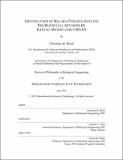| dc.contributor.advisor | Jacquin C. Niles. | en_US |
| dc.contributor.author | Birch, Christina M. (Christina Marie) | en_US |
| dc.contributor.other | Massachusetts Institute of Technology. Department of Biological Engineering. | en_US |
| dc.date.accessioned | 2015-09-29T18:09:00Z | |
| dc.date.available | 2015-09-29T18:09:00Z | |
| dc.date.copyright | 2015 | en_US |
| dc.date.issued | 2015 | en_US |
| dc.identifier.uri | http://hdl.handle.net/1721.1/98922 | |
| dc.description | Thesis: Ph. D., Massachusetts Institute of Technology, Department of Biological Engineering, 2015. | en_US |
| dc.description | This electronic version was submitted by the student author. The certified thesis is available in the Institute Archives and Special Collections. | en_US |
| dc.description | Cataloged from student-submitted PDF version of thesis. | en_US |
| dc.description | Includes bibliographical references (pages 95-103). | en_US |
| dc.description.abstract | Malaria kills over 500,000 people annually, the majority of whom are children under five years old in sub-Saharan Africa. This disease is caused by several parasite species, of which Plasmodium falciparum is associated with the highest mortality. The clinical manifestations of malaria are associated with the phase of infection where parasites develop within red blood cells (RBCs). Infected RBCs can adhere to the host microvasculature, triggering inflammatory responses in affected organs that contribute to the pathophysiology of life threatening cerebral malaria and pregnancy-associated malaria. The expression of specific Plasmodium falciparum Erythrocyte Membrane Protein 1 (PfEMP1) variants on the RBC surface is associated with severe disease, such as VAR2CSA-mediated placental sequestration during pregnancy-associated malaria. While parasite proteins expressed on the surface of infected RBCs are linked to disease pathogenesis, this surface proteome is poorly characterized. Identifying parasite-derived antigens on the infected RBC surface could facilitate diagnosis, monitoring, and prevention of sequestration. To interrogate the infected RBC surface proteome, we require a panel of affinity reagents that robustly distinguish the parasite-derived proteins from the elaborate RBC surface milieu. Nucleic acid aptamers are widely used in biological applications for their high specificity and affinity to targets and are highly suitable for malaria applications. Efficiently generating aptamers against complex targets-such as whole cells-remains a challenge. Here we develop a novel strategy (I-SELEX) that utilizes inertial focusing in spiral microfluidic channels to stringently partition cells from unbound oligonucleotides. We use I-SELEX to efficiently discover high affinity aptamers that selectively recognize distinct epitopes present on target cells. Using first an engineered RBC model displaying a non-native antigen and, second, live malaria parasite-infected RBCs as targets, we establish suitability of this strategy for de novo aptamer selections. We demonstrate recovery of a diverse set of aptamers that recognize distinct epitopes on parasite-infected RBCs with nanomolar affinity, including an aptamer against the protein responsible for placental sequestration, VAR2CSA. These findings validate I-SELEX as a broadly applicable aptamer discovery platform that enables identification of new reagents for mapping the parasite-infected RBC surface proteome at higher molecular resolution to potentially contribute to malaria diagnostics, therapeutics and vaccine efforts. | en_US |
| dc.description.statementofresponsibility | by Christina M. Birch. | en_US |
| dc.format.extent | 103 pages | en_US |
| dc.language.iso | eng | en_US |
| dc.publisher | Massachusetts Institute of Technology | en_US |
| dc.rights | MIT theses are protected by copyright. They may be viewed, downloaded, or printed from this source but further reproduction or distribution in any format is prohibited without written permission. | en_US |
| dc.rights.uri | http://dspace.mit.edu/handle/1721.1/7582 | en_US |
| dc.subject | Biological Engineering. | en_US |
| dc.title | Identification of malaria parasite-infected red blood cell aptamers by inertial microfluidics SELEX | en_US |
| dc.type | Thesis | en_US |
| dc.description.degree | Ph. D. | en_US |
| dc.contributor.department | Massachusetts Institute of Technology. Department of Biological Engineering | |
| dc.identifier.oclc | 921844550 | en_US |
